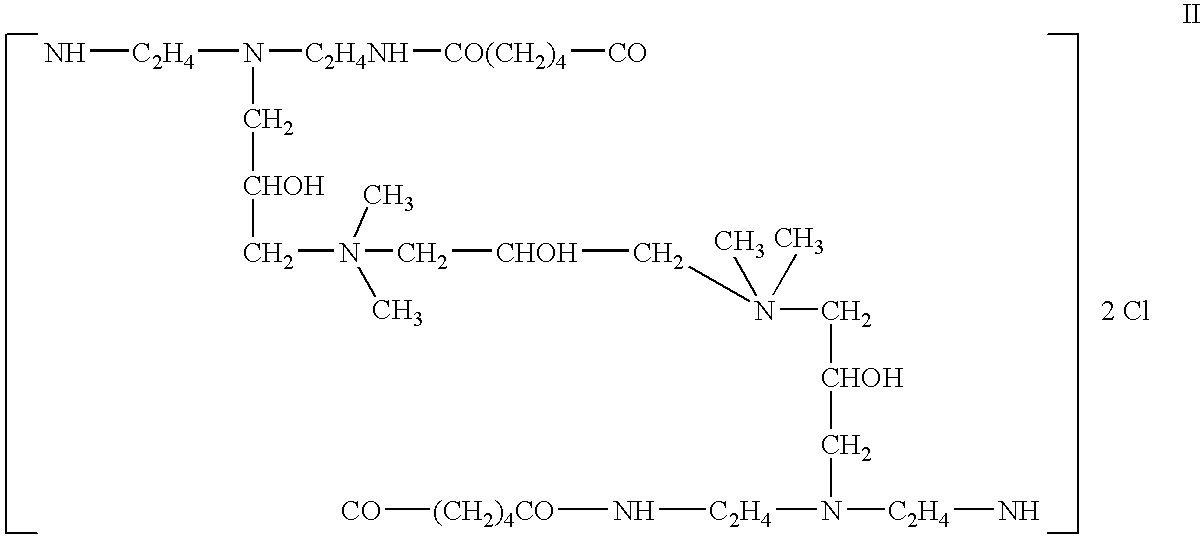Softening laundry detergent
a laundry detergent and softening technology, applied in detergent compounding agents, liquid soaps, organic chemistry, etc., can solve the problems of affecting the cleaning performance of detergents, garments feel harsh after washing, and many existing technologies still have disadvantages,
- Summary
- Abstract
- Description
- Claims
- Application Information
AI Technical Summary
Benefits of technology
Problems solved by technology
Method used
Image
Examples
example 1
[0144] This example demonstrates that inclusion of a cationic polymer in the detergent is the cause of redeposition of the particulate soil. The following two formulas were tested for graying—formulation 1 did not contain cationic polymer, while formulation 2 did contain cationic polymer.
TABLE 3Formulation 1Percent in FormulaIngredient(based on 100% active)linear alkylbenzene sulfonic acid8.0coconut oil fatty acid8.0alcohol ethoxylate10.0alcohol ethoxy sulfate3.0sodium hydroxide2.5Triethanolamine1.0Sorbitol5.0propylene glycol4.0Protease0.5sodium borate3.0fluorescent whitening agent0.15Waterto 100
[0145]
TABLE 4Formulation 2Percent in FormulaIngredient(based on 100% active)linear alkylbenznene sulfonic acid8.0coconut oil fatty acid8.0alcohol ethoxylate10.0alcohol ethoxy sulfate3.0sodium hydroxide2.5Triethanolamine1.0Sorbitol5.0propylene glycol4.0Protease0.5sodium Borate3.0fluorescent whitening agent0.15Polymer LR 40010.30Waterto 100
1A cationic cellulose polymer available from the Ame...
example 2
[0147] Examples 2 and 3 illustrate how the antiredeposition performance of fabric softening compositions comprising cationic polymers can be improved without negatively impacting their conditioning properties. The following formulas were tested for graying:
TABLE 5Formulations 3-5Formulation NumberDescription3Formulation 2 plus 0.42% PVP K-1514Formulation 2 plus 0.42% Alcosperse72525Formulation 2 plus 0.3% PVP K-15 and0.12% Alcosperse 725
1Polyvinylpyrrolidone available from International Specialty Chemicals, Wayne, NJ.
2A polyacrylate available from the Alco division of National Starch and Chemical Co. which is a division of Imperial Chemical Industries, Chattanooga, TN.
[0148] Graying results are shown in the Table below:
TABLE 6Graying ResultsFormulationDelta E31241257
[0149] As can be seen from the tables above, only the combination of PVP and Alcosperse significantly reduces the amount of redeposition of clay to the terry towels.
example 3
[0150] This example demonstrates that certain anionic polymers, but not the polymers identified in this application, are prone to deactivating the fabric softening ability of cationic polymers when formulated into liquid detergent products. Formulations 6-9 were prepared and tested for softening, and compared with Formulation 2 as shown in the table below.
TABLE 7Formulations 6-9FormulationSofteningNumberDescriptionParameter21016Formulation 2 plus 0.3% Flexan 1301227Formulation 2 plus 0.3% low molecular-10weight polystyrene sulfonate28Formulation 2 plus 0.3% Kelzan HP3659Formulation 2 plus 0.3% Alcosperse1047254
1A high molecular-weight polystyrene sulfonate available from the National Starch and Chemical Company, which is a division of Imperial Chemical Industries, Bridgewater, NJ.
2Available from the National Starch and Chemical Company, which is a division of Imperial Chemical Industries, Bridgeewater, NJ.
3Xanthan gum, available from CP Kelco, San Diego, CA.
4A polyacrylate avai...
PUM
| Property | Measurement | Unit |
|---|---|---|
| Fraction | aaaaa | aaaaa |
| Mass | aaaaa | aaaaa |
| Fraction | aaaaa | aaaaa |
Abstract
Description
Claims
Application Information
 Login to View More
Login to View More - R&D
- Intellectual Property
- Life Sciences
- Materials
- Tech Scout
- Unparalleled Data Quality
- Higher Quality Content
- 60% Fewer Hallucinations
Browse by: Latest US Patents, China's latest patents, Technical Efficacy Thesaurus, Application Domain, Technology Topic, Popular Technical Reports.
© 2025 PatSnap. All rights reserved.Legal|Privacy policy|Modern Slavery Act Transparency Statement|Sitemap|About US| Contact US: help@patsnap.com



